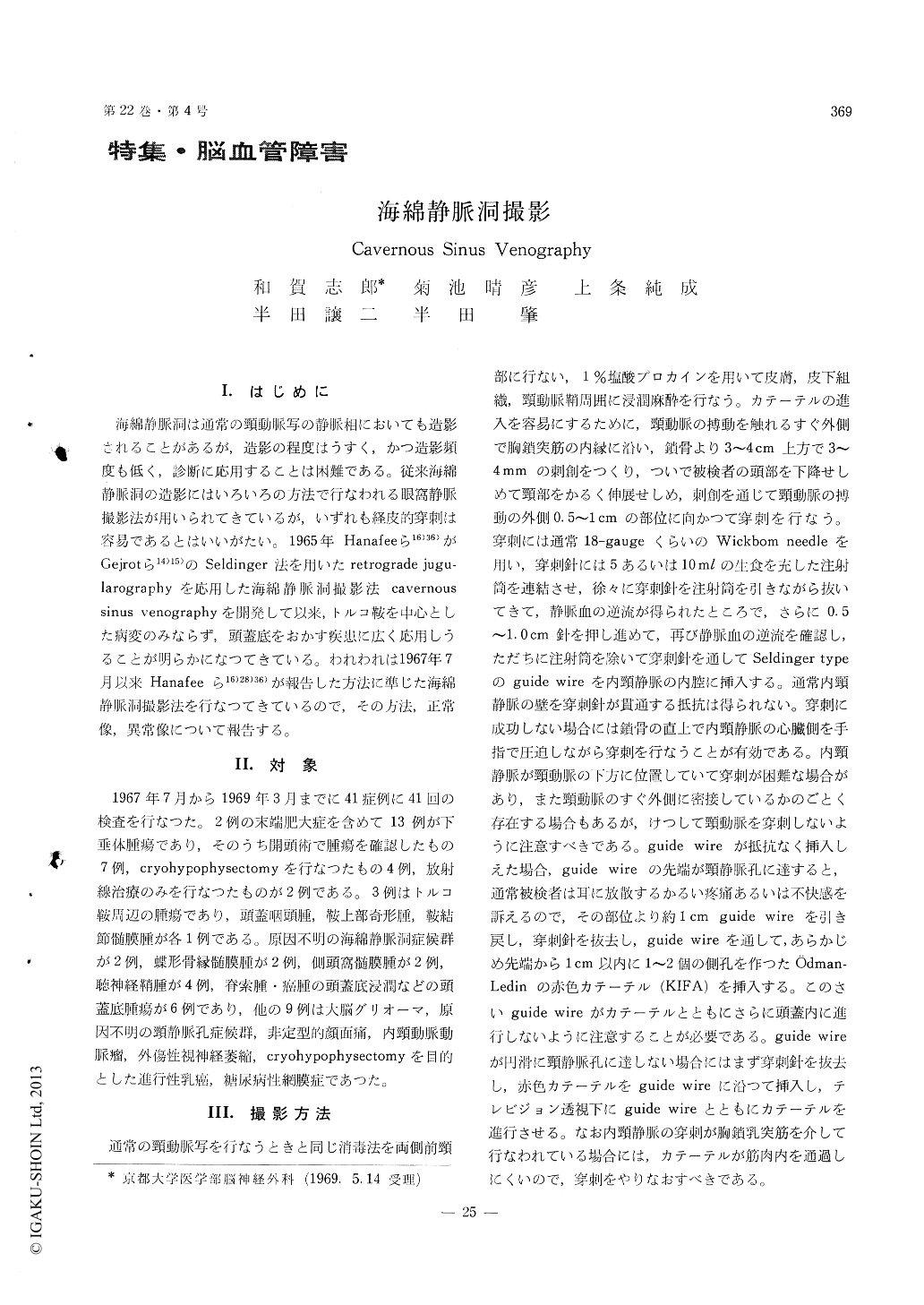Japanese
English
- 有料閲覧
- Abstract 文献概要
- 1ページ目 Look Inside
I.はじめに
海綿静脈洞は通常の頸動脈写の静脈相においても造影されることがあるが,造影の程度はうすく,かつ造影頻度も低く,診断に応用することは困難である。従来海綿静脈洞の造影にはいろいろの方法で行なわれる眼窩静脈撮影法が用いられてきているが,いずれも経皮的穿刺は容易であるとはいいがたい。1965年Hanafeeら16)36)がGejrotら14)15)のSeldinger法を用いたretrograde jugu—larographyを応用した海綿静脈洞撮影法cavernoussinus venographyを開発して以来,トルコ鞍を中心とした病変のみならず,頭蓋底をおかす疾患に広く応用しうることが明らかになってきている。われわれは1967年7月以来Hanafeeら16)28)36)が報告した方法に準じた海綿静脈洞撮影法を行なってきているので,その方法,正常像,異常像について報告する。
Cavernous sinus venography by the jugular route is a refined modification of retrograde jugularo-graphy. Under fluoroscopic control Ödman-Ledin red catheter is percutaneously introduced into the jugular vein by Seldinger technique and reaches the jugular bulb, where the tip of the catheter is directed anteromedially to the orifice of the inferior petrosal sinus. The catheter is usually inserted bilaterally. Venography is accomplished by bilateral simultaneous forceful hand injection of 8 to 10 mlof 60% Urografin.
The present study is based on 41 examinations performed from July 1967 through March 1969. Thirteen studies were performed for pituitary ade-nomas and five were for another sellar lesions. Six were for invading skull base tumors. Four had meningiomas of the sphenoid ridge and in the temporal fossa, and another four had acoustic neu-rinomas. Other nine were of miscellaneous group.
Cavernous sinus venography was helpful in the following conditions : (1) Occlusion, compression or displacement of the internal jugular vein, sigmoid and/or transverse sinuses. (2) Tumors in the sellar region, especially when bone changes may be in-conclusive or even misleading, and/or when carotid angiography and pneumoencephalography reveal no clear evidence of mass lesion. In the early stage of development of the pituitary tumor there were asymmetric lobulated defects in the medial and/or lower wall of the cavernous sinus, and the anterior intercavernous sinus became less opacified. As the tumor grows, the cavernous sinus was displaced laterally or upwards, or both and finally became less opacified or not opacified. (3) The advent of cryohypophysectomy requires precise delineation of the pituitary gland or tumor. The lateral extentof the gland or tumor can be delineated precisely with this venography. (4) Skull base tumors, especi-ally those invading the bone of the base of the skull such as chordomas and cancer of the epipharynx.
The cavernous sinus may be opacified by orbital phlebography performed in various methods. How-ever, injecting contrast material percutaneously into the angular, frontal or facial vein is of consider-able technical difficulty except for in patients with dilated veins of the face.
The cavernous sinus venography is method of choice for delineating the venous system of the base of the skull, and it is a simpler and safer method because, according to Hanafee and his asso-ciates, (1) the brain is not perfused with contrast material, (2) the danger of cerebral embolism by air bubbles or clots does not exist, (3) no premedi-cation is necessary and the examination can be performed on an outpatient, and (4) a lower pres-sure vein is the site of puncture and there is little danger of producing hematoma.
The use of finer catheters and subtraction techni-que will give more precise informations as to the veins of the base of the skull.

Copyright © 1970, Igaku-Shoin Ltd. All rights reserved.


